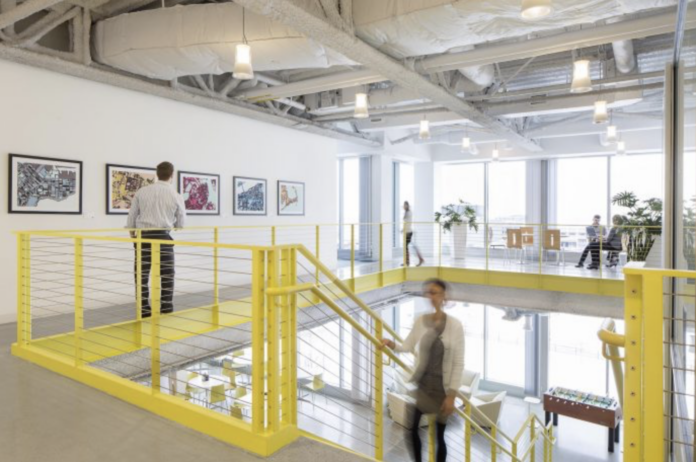Workplaces can often feel like a maze of desks, hallways, and doors. Because our brains hold onto memorable environmental features, art can usefully function as a landmark, helping people traveling through a space to remember where they’ve been. It can also come in handy when providing directions.
Amidst many options for addressing branding and company culture in the workplace, art can help communicate key brand messages in a non-verbal way… By this same token, if the art in place illustrates issues of common concern and collective identity — such as environmentally-responsible behavior or pediatric health — it can support a feeling of unity, whether among employees or between an organization and its clients.
Akin to its proven rehabilitative influence in hospitals, art in the workplace has also been shown to benefit employee well-being and performance. This is significant, as the office can easily become a place of stress and tension, and people become cognitively exhausted after prolonged periods of highly focused work. Viewing artwork, particularly realistic nature scenes, helps workers restore mental energy and reduce stress. Unsurprisingly, both of these effects boost brain performance. Seeing nature images in artwork has also been linked to lower levels of anger in workplaces. One in four American workers report feeling chronically angry, which has been linked to negative outcomes such as retaliatory behavior, interpersonal aggression, poor work performance, absenteeism, and increased turnover. People who work in environments decorated with aesthetically engaging art typically experience less stress and anger in response to task-related frustration, and thus help to build a more collaborative and enjoyable workplace.
Well-considered art decisions for the workplace will consider the particular effects of content, texture, scale, and positioning. Positive mood inducing images of the natural world often feature grassy areas interspersed with clumps of deciduous trees, green foliage, a view to the horizon, a gently flowing body of water, and a foreground area into which the viewer might step. For the best effect, these views should be from a slightly elevated position — like looking down into a verdant valley. When it comes to depictions of humans, conjuring images of our distant past — in the form of visualizing older generations — has been linked to improved performance on intelligence tests. Artwork that shows people being cared for reduces strong responses to threatening or stressful situations by reminding us of feeling loved. This state of mind promotes more effective functioning during stressful situations, and greater activation of soothing mental resources afterward.
Analysis:
In this article, people from PLASTARC share many positive effects that different kinds of art can bring to employees and visitors. The article also dives into the ideas about how to pick and choose the best art for your workplace. Research across the US and Europe shows that displaying art at work can improve employee performance, mood, and well-being. I think that this is a good article to bring into my project because the way art is brought into the space can change the way




